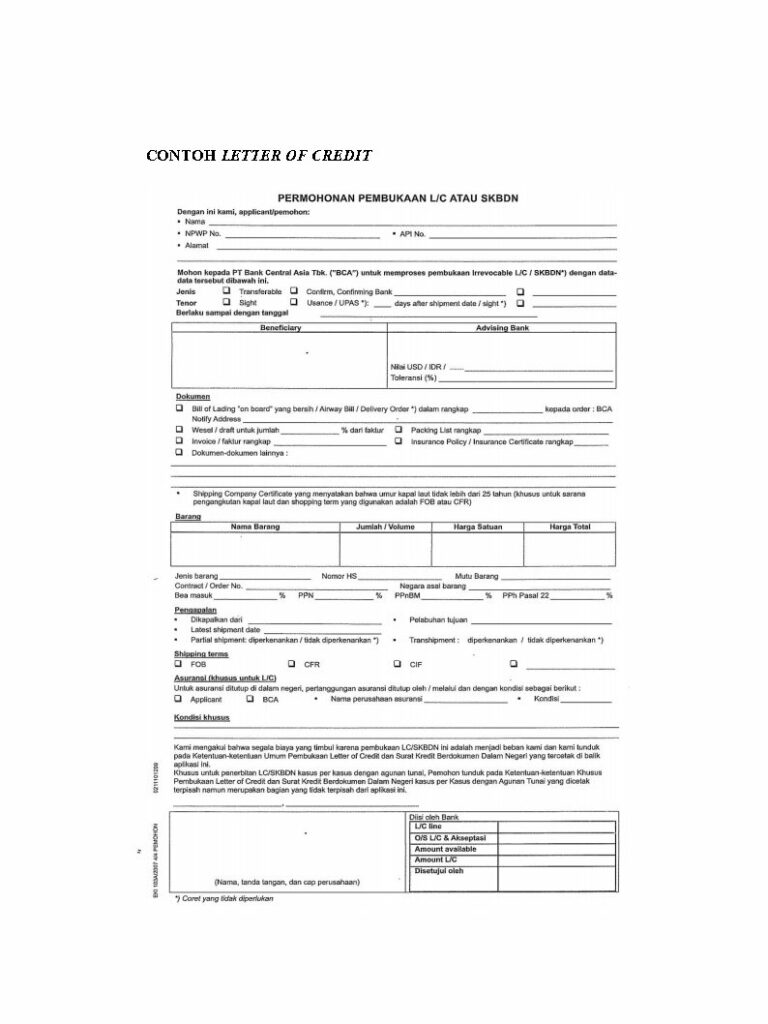Transportation is one of the most important parts of overseas trade, whether by land, air, or sea. When it comes to exporting and importing in Indonesia, there are some documents that you need to provide when you want to transport your goods, One of the them is Bill of Lading (B/L).
What is a Bill of Lading (B/L) ?
Bill of Lading (B/L) is a receipt for the transportation of goods as an intermediary between the shipper and the consignee. Besides that, it is also evidence of the contract for transportation. Moreover, this document also serves as an agreement for the transportation and delivery of the goods to the carrier and as a guarantee of the goods in the process of shipment.
Bill of lading has 2 types based on the transportation it uses. These are Seaway Bill of Lading which is a proof of goods sent by sea and Airway Bill of Lading which transports by air.
Parties in Bill of Lading.
When doing import to Indonesia, there are several parties in the making of the B/L, which are:
1. Shipper
The shipper is the one who acts as the beneficiary or consignor (exporter).
2. Carrier
Carrier is a transport or forwarding or a shipping company.
3. Notify Party
Notify Party is the party specified in the letter of credit.
4. Consignee
Consignee is the one who is the recipient of the goods (importer).
Main Function of Bill of Lading
In general, B/L has the following functions:
1. Proof of Receipt of Goods
This works as a proof that carrier has received the goods from the consignor or exporter to a destination and then delivered to the consignee or importer.
2. Proof of Ownership of Goods
In this document, it states that there is ownership of the transported goods.
3. As a Contract
Besides as a proof, it also serves as proof of contract for the transportation and delivery of goods between the carrier and the delivery.
Types of Bill of Lading
There are several types of B/L based on the delivery process. B/L are:
1. Combined Transport B/L.
This is the case when there is a combination of other transport services in the shipping process, especially land transport.
2. Charter of Party B/L.
This is the type when the shipper and consignee agree to use transportation in bulk by hiring all or part of the vessel.
3. Liner B/L.
Liner B/L is a document used when a ship already has an organized schedule and route.
4. Long Form B/L.
The Long Form B/L is a supplementary bill to the bill of lading, containing a record of the goods loaded together with the detailed conditions of carriage.
5. Short Form B/L.
The Short Form B/L is similar to the Long Form Bill of Lading but has simpler content with no conditions of carriage.
6. Through B/L.
The through B/L is a special document issued when there is no shipping service delivering directly to the port of destination, so that transhipment is required.
7. Shipped on Board B/L.
This B/L is issued after the shipping company has confirmed that the goods have been loaded onto the ship.
8. Received for Shipment B/L.
This type of B/L document is used to show that the goods to be shipped have been received by the shipping company. However, in doing so, the goods are not necessarily shipped or even loaded onto the ship. Therefore, the Received for Shipment bill of lading carries several risks such as possibility the goods will be loaded onto another vessel. If so, the goods may be neglected or damaged. Besides that, there may be additional charges or costs for warehouse rental or other necessities.

Type of B/L Based on The Goods Received
the condition of a B/L may be divided into several categories, according to the condition of the goods received:
1. Clean B/L
A clean B/L is one which there are no notations of defects in the goods and which states that the goods were loaded in good and complete condition without defects.
2. Unclean B/L
This type, stating that the goods do not comply with the terms of the letter of credit and the goods are damaged.
3. Stale B/L
Stale B/L states that it has not reached the consignee or his agent when the ship carrying the goods has arrived at the port. If the goods are not picked up immediately at the port of destination, problems can arise, such as the possibility of theft and loss of a small portion of the loaded goods, the imposition of daily fines by the port resulting in demurrage charges, or the sale of your goods at public auction.
Ownership of Bill of Lading
Ownership of a B/L may be based on several things, including:
1. Bearer Bill of Lading
This type of B/L is rarely used. “Bearer” means the holder of the bill of lading and thus anyone holding or possessing the bill of lading can collect the goods specified in the bill of lading.
2. "Made Out to Order" Bill of Lading
This one contains the phrase “consigned to order of” before or after the name of the consignee or to the notification address. Normally, this condition is indicated by the word “Order” on the consignee field of the Bill of Lading in question. Besides that, ownership of this type can be transferred by the consignee to another person by signing the reverse side of the Bill of Lading.
3. Straight Bill of Lading
This is when a Bill of Lading is stating the name of the recipient. For instance, it uses the words “consigned to” or “to” placed above the address of the consignee.
In conclusion, it is important to pay attention to the details of the bill and which ones you need to use. This way, your importing activities will go without any unnecessary loss. However, we understand that the processing of import documents requires a lot of effort. Feel free to contact us for more information on importing goods to Indonesia and the documents, or Sign Up to our platform directly to get easy access of import export platform.







